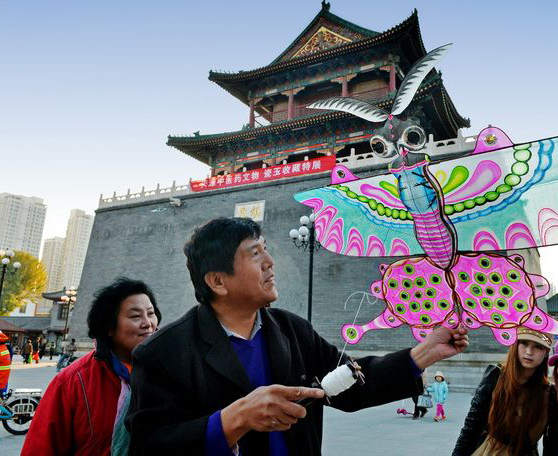Tianjin’s Wei Kite style glides through history beneath clouds

The Tianjin Wei Kite craftsman Wei Guoqiu shows his work.
Kites have been a part of Chinese history for centuries. Kites may look like they are made from simple components, but they require a painstaking construction process. Selecting the materials then designing, constructing and flying the kites are all tasks that require artistry, involving generations of wisdom from master craftsmen.
In ancient China, kites were known as “paper eagles.” It is said that ancient Han people used kites as a measurement tool and as a form of signal. They even attempted to utilize kites to realize people’s dream of flying. During the Five Dynasties, it is recorded that the eunuch Li Ye made a kite at the palace and tied a bamboo flute on the head of the kite. When the kite flew in the sky, the wind passed through the flute, sounding like a zither playing. That’s how Chinese kites gained their name, since kite, or fengzheng in Chinese, literally means the zither of wind.
Initially, Chinese kites were only a toy of the court and nobility. After the Song and Yuan dynasties, kites gradually spread out among the common people. During the Ming and Qing dynasties, they became widely spread. Tianjin is one of the most famous sources of Chinese kites. Tianjin kites are made of natural materials, including moso bamboo, silk, paper and mineral pigments. They are famous for their long history and the skill involved in making them. A piece of the Yangliuqing woodblock New Year’s painting in the Qing Dynasty, Ten Beauties Flying Kites, shows that there were 10 styles of Tianjin kites at that time. In the late Qing Dynasty and the early republican period, there were many kite workshops and craftsmen in Tianjin.
In the Republican Era, one of the most outstanding kite craftsmen in Tianjin was my great-grandfather Wei Yuantai. He was born in a humble family in 1872, and dropped out of school at an early age. At 16, my great-grandfather worked as an apprentice at a workshop and learned the superb craft of making kites. After his apprenticeship, he opened his own workshop and lived on making kites afterward.
He followed previous craftsmen’s steps and constantly developed kite making technologies, forming five unique artistic characteristics—varied styles, life-like paintings, steady flying, amazing flying stunts and portability. At that time, my great-grandfather’s unique kite-making skills outshone others in Tianjin and earned the title “Kite Wei” among the people.
In 1912, 11 kites made by my great-grandfather were selected by the Ministry of Commerce and Agriculture of Beiyang Government to join the Panama Pacific International Exposition. His kites won both the gold award and honor for China. This was the first time that a Chinese craftsman flew Chinese kites on the global stage.
In 2008, manufacturing skills involved in Wei Kites were enrolled in the list of national intangible cultural heritage. Through hundreds of years’ history and by four generations’ inheritance and diligent effort, Wei Kite style is gliding from China to the world.
I always recalled what my grandfather Wei Shenxing, from the second generation of Wei Kite craftsmen, told me. He said that both making kites and conducting oneself should be down to earth and steadfast. He warned me to take on the responsibility of carrying forward the crafting skills involved in Wei Kites and I think I have achieved this. Also, I introduced Wei Kites to many foreign friends and won global praise. One year, I went abroad and the local people tried to encourage me to stay there. They offered me a high salary, but I flatly refused. Because I believe that the string of a Wei Kite is held in China, and no matter how its stage expands, the string cannot break in my hands.
Wei Guoqiu is a fourth generation of Tianjin Wei Kite craftsman.

 PRINT
PRINT CLOSE
CLOSE